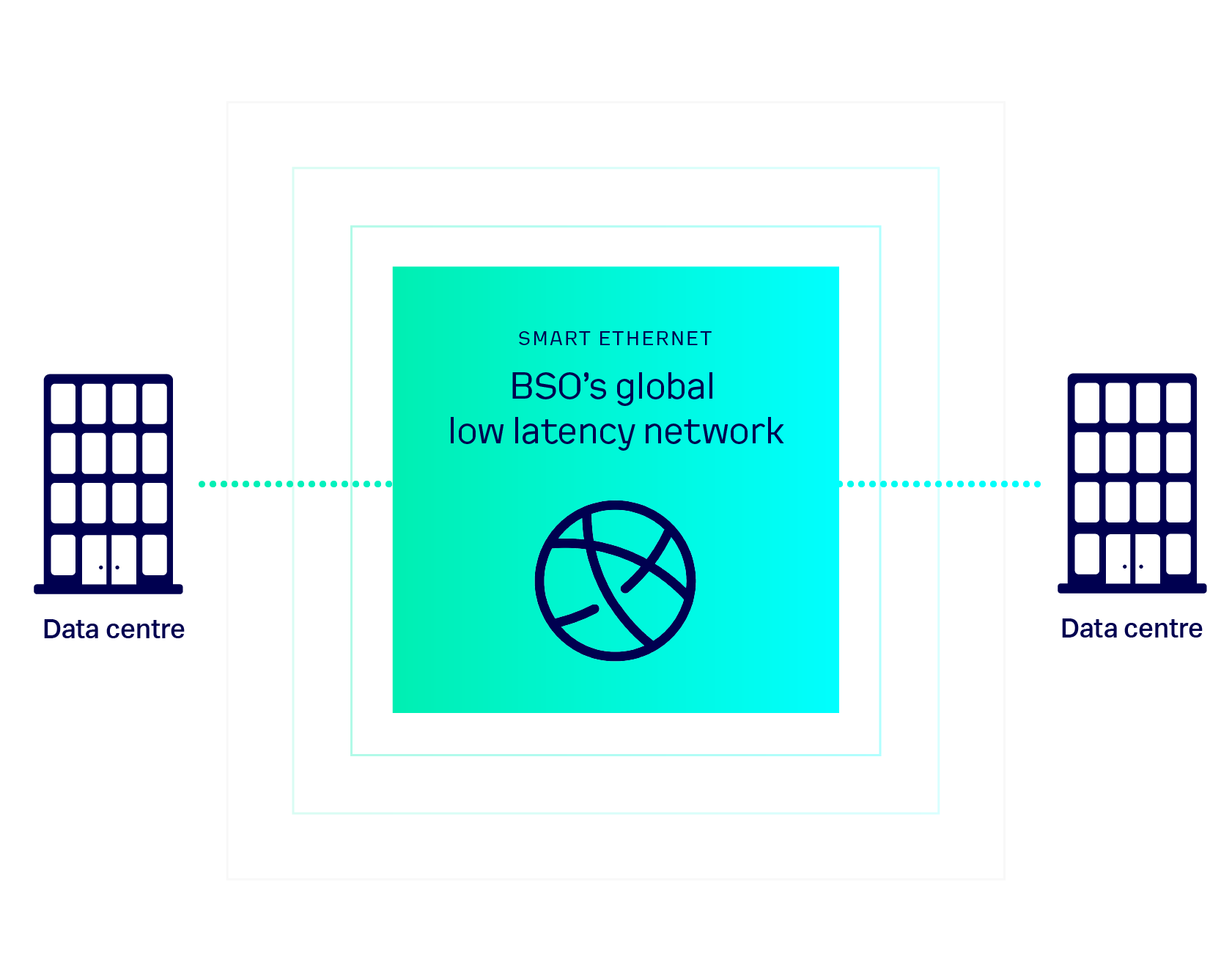PRODUCTS
Smart Ethernet_
Network interconnection
made easy_
Reliable connectivity defines business success. BSO Smart Ethernet provides the simplest, fastest method to spin-up dedicated secure connections across any of BSO’s sites, globally.
OUR SERVICE
Self-healing ethernet connectivity_
BSO Smart Ethernet connects two points in your data center managed services network over a secure, highly redundant mesh network.
BSO Smart Ethernet is a self-healing, protected service that self-selects its paths, shares traffic loads and thanks to a low-oversubscription ratio, ensures the best price/performance ratio for your business.
Connections can be formed from 100Mbps to 100Gbps* with automatic failover built-in.
*Speeds greater than 10Gbps may not be available in all markets.

OUR DIFFERENCE
Why choose BSO Smart Ethernet?
Value at every point
Pay for a single service with the redundancy capabilities of a high-availability product.
Global diversity
Experience a consistent service around the clock.
Simple, rapid deployment
Once master ports are operational, we can provision your connection(s) in less than 24 hours.
PRODUCT SHEET
BSO Smart Ethernet product sheet_
Not on-net with BSO?
Get in touch to learn
more about the power of BSO Smart Ethernet_
FAQs
What is Smart Ethernet?
BSO Smart Ethernet is a networking solution that securely connects two points within your data center managed services network. It operates over a secure and highly redundant mesh network.
It allows organisations to dynamically adjust network resources, optimise bandwidth, and prioritise traffic based on real-time demands. It is designed to enhance network efficiency, scalability, and performance by adapting to changing network conditions and application requirements, all while offering the reliability and simplicity of traditional ethernet connectivity.
How does BSO Smart Ethernet improve network performance?
BSO Smart Ethernet improves network performance through:
Self-healing: Automatically reroutes traffic during disruptions, reducing downtime.
Load sharing: Distributes traffic for efficient resource usage and consistent performance.
Low oversubscription: Avoids overloading network resources, ensuring cost-effective performance.
Flexible bandwidth: Scales from 100Mbps to 100Gbps to meet specific requirements.
Automatic failover: Swiftly switches to alternative paths to maintain network uptime.
What are the key features of BSO Smart Ethernet?
BSO Smart Ethernet boasts several key features, tailored to meet your networking needs. These include:
Flexible speed options: With speeds ranging from 10Mbps to 10Gbps, BSO Smart Ethernet provides multiple configuration choices to accommodate your specific bandwidth requirements.
Unprotected configuration: BSO Smart Ethernet offers an unprotected configuration with a single linear circuit, ideal for straightforward connectivity.
Protected revertive configuration: This option utilises diverse circuits, defining a primary path that is used whenever possible. In the event of a network issue, the system can revert back to the primary path, ensuring continuity of service.
Protected non-revertive configuration: In this setup, diverse circuits are employed, and an alternate path is activated when the active path experiences an issue. Unlike the revertive configuration, it does not automatically return to the primary path once restored, providing additional redundancy and control.
These key features of BSO Smart Ethernet give you the flexibility to select the configuration that aligns best with your network's redundancy and performance requirements.
How does BSO Smart Ethernet improve network security?
BSO Smart Ethernet significantly enhances network security by leveraging its physical connectivity advantages over Wi-Fi. While Wi-Fi can be secured with strong encryption and firewalls, it remains vulnerable, especially in the era of the Internet of Things (IoT), where numerous wireless devices increase the potential attack surface.
Here's how BSO Smart Ethernet improves network security:
Physical security: Ethernet connections require physical access, making it inherently more secure. Hackers and malicious entities find it much more challenging to gain access to a physical ethernet connection compared to wireless networks. This physical barrier acts as a deterrent against unauthorised access and intrusion attempts.
Limited attack surface: In contrast to wireless connections that can be accessed from anywhere within signal range, ethernet connections have a limited physical reach. This limits the opportunities for external threats to attempt network infiltration. Attackers looking to steal sensitive information are more likely to target wireless networks, which are easier to breach compared to physically breaking into a business or office.
By relying on ethernet, BSO Smart Ethernet mitigates security risks associated with wireless connections, providing a more robust and reliable defense against unauthorised access and potential breaches.
Can BSO Smart Ethernet support multiple devices and protocols?
BSO Smart Ethernet is designed to be flexible and accommodating when it comes to supporting multiple devices and network protocols. It can handle diverse devices and traffic typically encountered in modern networking environments. Here's how:
Device compatibility: BSO Smart Ethernet supports a wide range of devices, including computers, servers, routers, switches, and more, ensuring compatibility with various network hardware.
Protocol versatility: BSO Smart Ethernet is protocol-agnostic, accommodating multiple network protocols like TCP/IP, UDP, HTTP, FTP, and others, making it suitable for diverse applications.
VLAN support: It also supports Virtual LANs (VLANs), allowing you to segment your network into virtual networks with distinct devices and protocols for efficient management.
Quality of Service (QoS): BSO Smart Ethernet includes QoS features for prioritising specific traffic or protocols, ensuring optimal performance for critical applications and services.
What are the benefits of using BSO Smart Ethernet for industrial applications?
BSO Smart Ethernet enhances the reliability, security, scalability, and efficiency of industrial networks, making it an ideal choice for critical applications in manufacturing, process control, and automation. Some of the significant benefits are:
Reliability and uptime: BSO Smart Ethernet's self-healing and protected configurations ensure high network availability. This is critical in industrial settings where downtime can lead to production losses, making it a reliable choice for maintaining continuous operations.
Security: The physical nature of ethernet connections makes them more secure compared to wireless alternatives, reducing the risk of unauthorised access or interference in industrial networks, which often handle sensitive data and processes.
Scalability: BSO Smart Ethernet supports a wide range of bandwidth options (from 10Mbps to 10Gbps), enabling industrial facilities to scale their network capacity to accommodate growing data demands and evolving technology requirements.
Efficiency: Load-sharing capabilities optimise network performance by preventing congestion and ensuring that network resources are used efficiently. This is crucial for industrial applications with real-time data requirements.
Low-latency: Ethernet typically offers low-latency, which is essential for real-time industrial applications such as process control, robotics, and automation.
Protocol compatibility: BSO Smart Ethernet is protocol-agnostic, supporting various industrial communication protocols, facilitating seamless integration into existing industrial networks.
Remote monitoring and management: Industrial networks often span large areas, and BSO Smart Ethernet allows for remote monitoring and management, reducing the need for physical interventions and maintenance, which can be costly and time-consuming.
Cost-effective: BSO Smart Ethernet's low oversubscription ratio ensures that you get the best price-to-performance ratio, making it a cost-effective choice for industrial applications.
Compliance: Ethernet technology often aligns with industry standards and regulations, ensuring that industrial networks remain compliant with safety and data privacy requirements.





/Revolutionising-Connectivity%20BSOs-Tailored-Cloud-Solution-for-CryptoStruct-GmbH.png?width=1050&height=550&name=Revolutionising-Connectivity%20BSOs-Tailored-Cloud-Solution-for-CryptoStruct-GmbH.png)
/6%20Cloud%20Best%20Practices%20for%20Financial%20Technology%20Companies.jpg?width=1200&height=600&name=6%20Cloud%20Best%20Practices%20for%20Financial%20Technology%20Companies.jpg)



